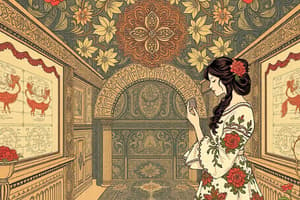Podcast
Questions and Answers
What is the primary focus of studying consumer buying behavior?
What is the primary focus of studying consumer buying behavior?
- Determining optimal pricing strategies
- Understanding consumer responses to marketing efforts (correct)
- Analyzing competitor strategies
- Identifying profit margins
Which factor primarily describes the values and behaviors learned from family and other institutions?
Which factor primarily describes the values and behaviors learned from family and other institutions?
- Cultural Factors (correct)
- Psychological Factors
- Economic Factors
- Social Factors
What is a subculture?
What is a subculture?
- A smaller group with distinct values within a culture (correct)
- A universal value system shared by all cultures
- A larger culture that dominates societal values
- A marketing strategy designed for mass appeal
Which of the following is NOT a category that affects consumer behavior?
Which of the following is NOT a category that affects consumer behavior?
Which element is part of the Stimulus-Response Model in consumer behavior?
Which element is part of the Stimulus-Response Model in consumer behavior?
How do cultural shifts affect marketing strategies?
How do cultural shifts affect marketing strategies?
What characterizes membership groups within social factors affecting consumer behavior?
What characterizes membership groups within social factors affecting consumer behavior?
What factors typically determine social class?
What factors typically determine social class?
What are aspirational groups defined as?
What are aspirational groups defined as?
How do opinion leaders primarily influence consumer behavior?
How do opinion leaders primarily influence consumer behavior?
Which factor affects the types of products individuals may purchase?
Which factor affects the types of products individuals may purchase?
What reflects a person's position in groups and impacts their buying behavior?
What reflects a person's position in groups and impacts their buying behavior?
What does Maslow’s Hierarchy of Needs primarily describe?
What does Maslow’s Hierarchy of Needs primarily describe?
How does lifestyle segmentation aid marketers?
How does lifestyle segmentation aid marketers?
Which brand personality trait is typically associated with Apple?
Which brand personality trait is typically associated with Apple?
Which of the following is true about perception?
Which of the following is true about perception?
What is selective retention in consumer behavior?
What is selective retention in consumer behavior?
Which type of buying behavior is characterized by high involvement and significant differences between brands?
Which type of buying behavior is characterized by high involvement and significant differences between brands?
What triggers need recognition in the buyer decision process?
What triggers need recognition in the buyer decision process?
Cognitive dissonance typically occurs after what stage of the buyer decision process?
Cognitive dissonance typically occurs after what stage of the buyer decision process?
How do marketers often influence consumer beliefs and attitudes?
How do marketers often influence consumer beliefs and attitudes?
During the evaluation of alternatives, what criteria might consumers consider?
During the evaluation of alternatives, what criteria might consumers consider?
Which of the following describes habitual buying behavior?
Which of the following describes habitual buying behavior?
What role do cues play in the learning process for consumers?
What role do cues play in the learning process for consumers?
Flashcards are hidden until you start studying
Study Notes
Consumer Buyer Behavior Overview
- Consumer Buyer Behavior: How individuals and households purchase goods and services for personal use
- Consumer Market: All final consumers who buy products or services for personal consumption
- Marketing Insights: Marketers strive to understand why, how, when, and where consumers make purchases to tailor their marketing strategies
Model of Consumer Behavior
- Stimulus-Response Model: Marketing stimuli (product, price, place, promotion) and other external factors influence consumer behavior, leading to responses like purchase choices and brand preferences
- Marketers Goal: Understanding how consumers react to different marketing strategies to predict and influence their choices
Factors Affecting Consumer Behavior
-
Cultural Factors:
- Culture: Influences values, perceptions, preferences, and behaviors learned from family and society
- Subculture: Distinct value systems within a broader culture, often based on ethnicity, religion, or geography.
- Social Class: Relatively permanent societal divisions based on income, education, and occupation, impacting product preferences.
-
Social Factors:
- Groups: Various groups that influence consumer behavior:
- Membership Groups: Direct influence from groups a person belongs to (e.g., friends, family).
- Aspirational Groups: Groups a person desires to belong to (e.g., celebrities).
- Reference Groups: Serve as comparison points (e.g., influencers)
- Opinion Leaders: Individuals within a reference group who influence others, often targeted in marketing campaigns.
- Family: The most significant consumer-buying organization, shaping individual preferences and brand loyalty.
- Groups: Various groups that influence consumer behavior:
-
Personal Factors:
- Age and Life-Cycle Stage: Needs and wants change throughout life stages, impacting purchasing decisions. (e.g., RBC Royal Bank categorizes stages like Youth, Getting Started, Builders, Accumulators, and Preservers)
- Occupation: Influencing the types of products purchased.
- Economic Situation: Income, savings, and interest rates influence consumer purchasing power.
- Lifestyle: Describes a person’s pattern of living in terms of activities, interests, and opinions (AIOs), used for market segmentation.
- Personality and Self-Concept: Unique psychological traits that influence behavior.
- Brand Personality: Traits used by brands to convey personality, like sincerity, excitement, competence, sophistication, and ruggedness (e.g., Apple is associated with excitement).
-
Psychological Factors:
- Motivation: A need that is pressing enough to direct an individual toward satisfying it.
- Motivation Research: Uses qualitative methods to uncover consumer motivations
- Maslow’s Hierarchy of Needs: A model that describes needs in a hierarchy, from basic physiological needs to self-actualization.
- Perception: How individuals select, organize, and interpret information.
- Selective Attention: Consumers filter out most information, focusing on what's relevant.
- Selective Distortion: Consumers interpret information in a way that supports their existing beliefs.
- Selective Retention: Consumers retain information that confirms their attitudes.
- Learning: Changes in behavior arising from experience.
- Drive: Internal stimulus motivating behavior.
- Cues: External signals that trigger a response.
- Response: The consumer's reaction.
- Reinforcement: Strengthening the response.
- Beliefs and Attitudes: Thoughts and consistent evaluations that shape preferences and buying choices.
- Motivation: A need that is pressing enough to direct an individual toward satisfying it.
Types of Buying Decision Behavior
- Complex Buying Behavior: High involvement and significant differences between brands, often for expensive or important products.
- Dissonance-Reducing Buying Behavior: High involvement, but few perceived differences between brands, leading to cognitive dissonance after purchase.
- Habitual Buying Behavior: Low involvement and minimal brand differences, common for everyday items.
- Variety-Seeking Buying Behavior: Low involvement, but significant perceived differences between brands, driven by a desire for variety rather than dissatisfaction.
Buyer Decision Process
- Need Recognition: The trigger for the buying process, starting with a perceived need.
- Information Search: Seeking information on the product from sources like personal, commercial, public, or experiential.
- Evaluation of Alternatives: Consumers assess different options based on criteria like brand reputation, quality, and price.
- Purchase Decision: Making a choice, potentially influenced by factors like others' opinions.
- Post-Purchase Behavior: Reflecting on the purchase, influenced by the alignment of expectations with the product's performance.
- Cognitive Dissonance: Post-purchase discomfort due to conflicting expectations and reality, leading to a need for reassurance.
Studying That Suits You
Use AI to generate personalized quizzes and flashcards to suit your learning preferences.




